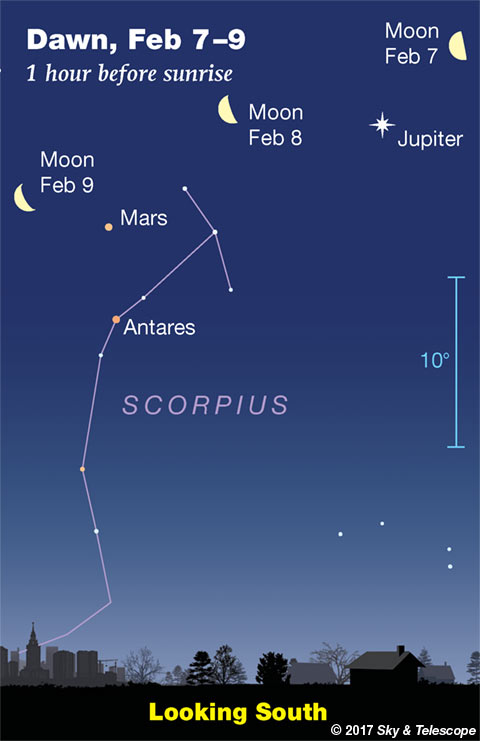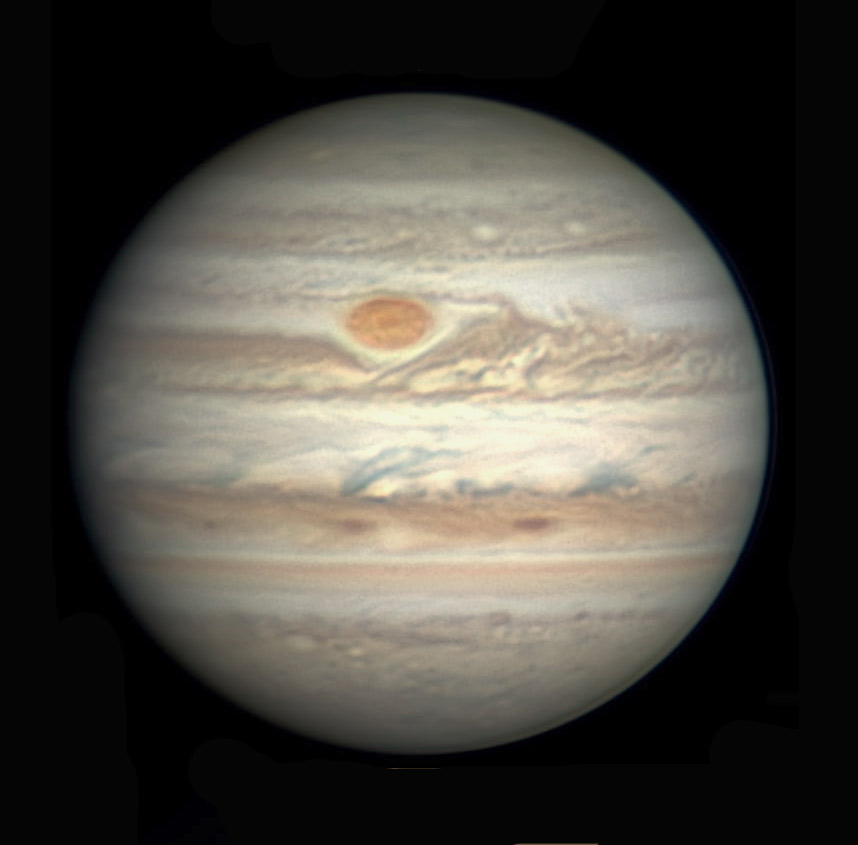Friday, February 2
• The sky's biggest asterism (informal star pattern) — at least the biggest that's widely recognized — is the Winter Hexagon. It fills the sky toward the east and south these evenings. Start with brilliant Sirius at its bottom. Going clockwise from there, march up through Procyon, Pollux and Castor, Menkalinan and Capella on high, down to Aldebaran, then to Rigel in Orion's foot, and back to Sirius.
Betelgeuse shines inside the Hexagon, off center.
Saturday, February 3
• After it’s good and dark, look due east, not very high, for twinkly Regulus. Extending upper left from it is the Sickle of Leo, a backward question mark. "Leo announces spring," goes an old saying. Actually, Leo showing up in the evening announces the cold, messy back half of winter. Come spring, Leo will already be high.
Sunday, February 4
• As soon as it's fully dark, Orion and the Winter Triangle shine high in the southeast. Sirius is the Triangle's brightest and lowest star. Betelgeuse in Orion' shoulder stands above Sirius by about two fists at arm's length. Left of them is the Triangle's third star, Procyon.
And standing above Procyon now (depending on your latitude) is 3rd-magnitude Gomeisa, or Beta Canis Minoris, the only other easy naked-eye star of Canis Minor.
Monday, February 5
• Betelgeuse, Orion's armpit, and Aldebaran, the bright eye of Taurus, are high in the south these evenings. Have you ever closely compared their colors? Can you detect any difference in their colors at all? I can't, really. Yet Aldebaran, spectral type K III, is often called an "orange" giant, while Betelgeuse, spectral type M1-M2 Ia, is usually called a "red" supergiant. Their temperatures are indeed a bit different: 3,910 Kelvin and 3,590 Kelvin, respectively.
A complication: Betelgeuse is brighter, and to the human eye, the colors of brighter objects appear, falsely, to be desaturated: tending paler (whiter) than they really are.

Tuesday, February 6
• The last-quarter Moon rises around midnight tonight. Jupiter rises below the Moon about 50 minutes later. By dawn on Wednesday the 7th they're high in the south — now with Jupiter lower left of the Moon, Mars farther to the lower left of Jupiter, and Antares below Mars, as shown here.
Wednesday, February 7
• The waning Moon rises around 1 a.m. tonight with Jupiter shining to its right or upper right. By dawn on Thursday the 8th they're high in the south — now with Jupiter to the right of the Moon, Mars to the Moon's lower left, and Antares below Mars, as shown here.
Thursday, February 8
• Before and during dawn on Friday morning the 9th, the Moon shines near Mars and Antares as shown here. Far to their upper right is brighter Jupiter.
Friday, February 9
• By 9 p.m. the Big Dipper stands straight up on its handle in the northeast. In the northwest, the W of Cassiopeia also stands on end at about the same height.
Saturday, February 10
• Sirius the Dog Star blazes high in the southeast after dinnertime, the brightest star of Canis Major. In a dark sky with lots of stars visible, the constellation's points can be connected to form a convincing dog profile. He's currently standing on his hind legs; Sirius is on his chest.
But through the kind of light pollution where most of us live, only his five brightest stars are easily visible. They form a short-handled meat cleaver. Sirius is the cleaver's top back corner, its blade faces right, and its handle is down below.
________________________
Want to become a better astronomer? Learn your way around the constellations! They're the key to locating everything fainter and deeper to hunt with binoculars or a telescope.
This is an outdoor nature hobby. For an easy-to-use constellation guide covering the whole evening sky, use the big monthly map in the center of each issue of Sky & Telescope, the essential guide to astronomy.

Once you get a telescope, to put it to good use you'll need a detailed, large-scale sky atlas (set of charts). The basic standard is the Pocket Sky Atlas (in either the original or Jumbo Edition), which shows stars to magnitude 7.6.
Next up is the larger and deeper Sky Atlas 2000.0, plotting stars to magnitude 8.5; nearly three times as many. The next up, once you know your way around, is the even larger Uranometria 2000.0 (stars to magnitude 9.75). And read how to use sky charts with a telescope.
You'll also want a good deep-sky guidebook, such as Sue French's Deep-Sky Wonders collection (which includes its own charts), Sky Atlas 2000.0 Companion by Strong and Sinnott, or the bigger Night Sky Observer's Guide by Kepple and Sanner.
Can a computerized telescope replace charts? Not for beginners, I don't think, and not on mounts and tripods that are less than top-quality mechanically (meaning heavy and expensive). And as Terence Dickinson and Alan Dyer say in their Backyard Astronomer's Guide, "A full appreciation of the universe cannot come without developing the skills to find things in the sky and understanding how the sky works. This knowledge comes only by spending time under the stars with star maps in hand."
This Week's Planet Roundup

Mercury and Venus are hidden in the glare of the Sun.
Mars and Jupiter (magnitudes +1.2 and –2.0, respectively) rise in the east-southeast in the hours after midnight. They're high in the south by early dawn. Jupiter, the first up, is the brightest point in the pre-dawn sky, shining in dim Libra. Mars glows about 15° to Jupiter's lower left in the head of Scorpius. Below Mars is Mars-colored Antares, almost the same brightness.
Saturn (magnitude +0.5, in Sagittarius) glows with a steady light low in the southeast in early dawn, about 30° lower left of Mars.
Uranus (magnitude 5.8, in Pisces) is still high in the southwest right after dark. Finder chart.
Neptune (magnitude 7.9, in Aquarius) is sinking very low in the west-southwest after dark.
______________________
All descriptions that relate to your horizon — including the words up, down, right, and left — are written for the world's mid-northern latitudes. Descriptions that also depend on longitude (mainly Moon positions) are for North America.
Eastern Standard Time (EST) is Universal Time (also called UT, UTC, GMT, or Z time) minus 5 hours.
______________________
"The dangers of not thinking clearly are much greater now than ever before. It's not that there's something new in our way of thinking, it's that credulous and confused thinking can be much more lethal in ways it was never before."
— Carl Sagan, 1996
______________________
"Objective reality exists. Facts are often determinable. Vaccines save lives. Carbon dioxide warms the globe. Bacteria evolve to thwart antibiotics, because evolution. Science and reason are not fake news, not a political conspiracy. Civilization's survival depends on our ability, and willingness, to use them."
— Alan MacRobert, your Sky at a Glance editor
______________________
"Facts are stubborn things."
— John Adams, 1770
______________________
"The most damaging consequences of [the current] Truth Decay include the erosion of civil discourse, political paralysis, alienation and disengagement of individuals from political and civic institutions, and uncertainty over national policy."
— RAND Corporation report, January 2018
 0
0








Comments
You must be logged in to post a comment.